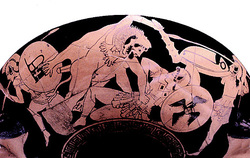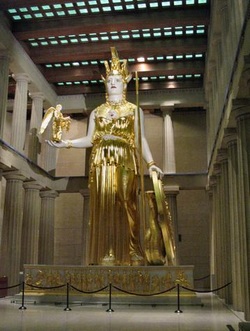Her.story

Many of heard of the “Amazon,”-the sexualization of histories warrior women archetype collides with the reality of her existence-that’s right, Amazons existed. Now before you go wiling about, or burst out into hostile laughter. I bid you not to do so, but to acquaint yourself with the facts and the archeological evidence supporting this ‘drastic’ claim. I’d first like you to visit the “Amazonium,” page, before you continue reading. It may take awhile for your brain to fathom the idea of true Amazons. So while you’re still on it, I’ll throw another blind-sider; female gladiators did exist as well….if you don’t believe me. Ask the archeologist who dug up the grave of one in the year 2000, or Cassius Dio-a historian who makes numerous accounts of them. As well as Juvenal, another historian, who does one of the most elaborate pieces on them, though he spited them. If you already indulged yourself in women’s history, you probably already know of such things and want to know more-further feeding the infatuation with the warrior women almost all cultures have.
This site is still in construction, but I promise you. You’ll be delighted at the final outcome. I’ll be going over countless well-known and not-so-well known female figures of history. From military tacticians, female kings, warrior-queens, empresses and female writers.
This site is still in construction, but I promise you. You’ll be delighted at the final outcome. I’ll be going over countless well-known and not-so-well known female figures of history. From military tacticians, female kings, warrior-queens, empresses and female writers.
Why (how) has women's history been "lost"?

Most have heard of Alexander the Great, Rameses || the Great, Cyrus the Great and Pompey the Great, but who has heard of: Empress Wu Zetian, Queen Zenobia, Aethelflaed or Queen Jhansi Ki Rani?
History is written in the perspective of the conqueror or the oppressor. Historians have always marginalized the significance of the oppressed, the conquered or excluded them entirely. Making it seem as if the minority were non-existent because of how minimized their role in history was or that, though they were present, their accomplishments and involvements in events were minute in accordance to how historians measure greatness. The female populace, as well as masses that are not of a non-Anglos, European ethnicity, such as Native Americans, Native Africans, Oriental Asians and Middle Eastern's, during the ages of antiquity, have yet to receive a balance incorporation of their historical contributions in a curriculum that is dominated by the achievements of the European Imperialist & Colonialism.
Histories timeline follows a specific people, usually when a non-related populace are mentioned; it is when they rise up as an opposing force (e.g.: The Huns are brought into the historical picture at around A.D 451 when they wage war against the Western Roman Empire. After the failed campaign of the Huns, because of the untimely death of their leader, Atilla, they fade away out of history). Other non-Anglos groups also gain an entitlement in history when their culture and politics become intertwined with that of the main timeline (e.g.: The Etruscans are recognized as being the primary influence of Greco-Roman civilization and that their socio-cultural system, practices and beliefs predominantly affected Roman tradition, as well as their mythology). When a woman's name is familiarized in history, it is when she establishes herself as a powerful figurehead which is akin to that of her male counterparts (e.g.: Ma'at-ka-Ra Hatshepsut, Female Pharaoh of Egypt who reigned for 2 decades during the 18th Dynasty of Ancient Egypt)-making her a threat to the patriarchal order. A woman also gains mention if she is involved with a man who has a vice grip on power and uses these relations to weave her way into the political realm (e.g.: Cleopatra the 7th, who receives favored acknowledgement by historians becomes of her enticing escapades with Julius Caeser and Marc Antony). Women also gain a seat behind or aside the throne of histories many 'greats' and renowned figures when she is a blood-relative or wedded to a man of power (e.g.: Julia Agrippina the Younger, a popularized historical figure because of her biological relation with Emperor Nero Germanicus or Livia Drusilla, Wife of Emperor Gaius Augustus, who advised her ruling husband for 51 years). The woman whose power is co-dependent, in essence, has no power, for her power is not her own, but is that of her husband's. Since she is dependent on his high ranking in the political hierarchy in order for her to maintain recognition.
History, has without a doubt, brushed over powerful figureheads-political, religious and other-whose sex, race or nationality has plagued them as a trait that justifies their belittled historical role. One of the populaces most disregarded would be the mass of the female sex, whose affiliations with the main histories of men has given them some spotlight, though the light shines dim. Most people could make quick reference to Queen Cleopatra because of her ties with a Greco-Roman general and Emperor, as well as the canonized, popularized female figure, Joan of Arc, whose acclamation is on basis of her Sainthood and influence in the A Hundred Years War against France. Other female historical figures are mostly known as the "Mother's of," "Wife of," "Daughter of,"-and do not carry any power to their entitlement without male affiliation. They title, is carried as a part of the patrilineal system that we still adhere to today (define "patrilineal": based on or tracing descent through the male line-World Net Web).
History is written in the perspective of the conqueror or the oppressor. Historians have always marginalized the significance of the oppressed, the conquered or excluded them entirely. Making it seem as if the minority were non-existent because of how minimized their role in history was or that, though they were present, their accomplishments and involvements in events were minute in accordance to how historians measure greatness. The female populace, as well as masses that are not of a non-Anglos, European ethnicity, such as Native Americans, Native Africans, Oriental Asians and Middle Eastern's, during the ages of antiquity, have yet to receive a balance incorporation of their historical contributions in a curriculum that is dominated by the achievements of the European Imperialist & Colonialism.
Histories timeline follows a specific people, usually when a non-related populace are mentioned; it is when they rise up as an opposing force (e.g.: The Huns are brought into the historical picture at around A.D 451 when they wage war against the Western Roman Empire. After the failed campaign of the Huns, because of the untimely death of their leader, Atilla, they fade away out of history). Other non-Anglos groups also gain an entitlement in history when their culture and politics become intertwined with that of the main timeline (e.g.: The Etruscans are recognized as being the primary influence of Greco-Roman civilization and that their socio-cultural system, practices and beliefs predominantly affected Roman tradition, as well as their mythology). When a woman's name is familiarized in history, it is when she establishes herself as a powerful figurehead which is akin to that of her male counterparts (e.g.: Ma'at-ka-Ra Hatshepsut, Female Pharaoh of Egypt who reigned for 2 decades during the 18th Dynasty of Ancient Egypt)-making her a threat to the patriarchal order. A woman also gains mention if she is involved with a man who has a vice grip on power and uses these relations to weave her way into the political realm (e.g.: Cleopatra the 7th, who receives favored acknowledgement by historians becomes of her enticing escapades with Julius Caeser and Marc Antony). Women also gain a seat behind or aside the throne of histories many 'greats' and renowned figures when she is a blood-relative or wedded to a man of power (e.g.: Julia Agrippina the Younger, a popularized historical figure because of her biological relation with Emperor Nero Germanicus or Livia Drusilla, Wife of Emperor Gaius Augustus, who advised her ruling husband for 51 years). The woman whose power is co-dependent, in essence, has no power, for her power is not her own, but is that of her husband's. Since she is dependent on his high ranking in the political hierarchy in order for her to maintain recognition.
History, has without a doubt, brushed over powerful figureheads-political, religious and other-whose sex, race or nationality has plagued them as a trait that justifies their belittled historical role. One of the populaces most disregarded would be the mass of the female sex, whose affiliations with the main histories of men has given them some spotlight, though the light shines dim. Most people could make quick reference to Queen Cleopatra because of her ties with a Greco-Roman general and Emperor, as well as the canonized, popularized female figure, Joan of Arc, whose acclamation is on basis of her Sainthood and influence in the A Hundred Years War against France. Other female historical figures are mostly known as the "Mother's of," "Wife of," "Daughter of,"-and do not carry any power to their entitlement without male affiliation. They title, is carried as a part of the patrilineal system that we still adhere to today (define "patrilineal": based on or tracing descent through the male line-World Net Web).
